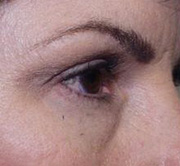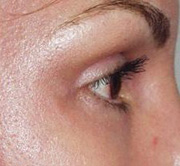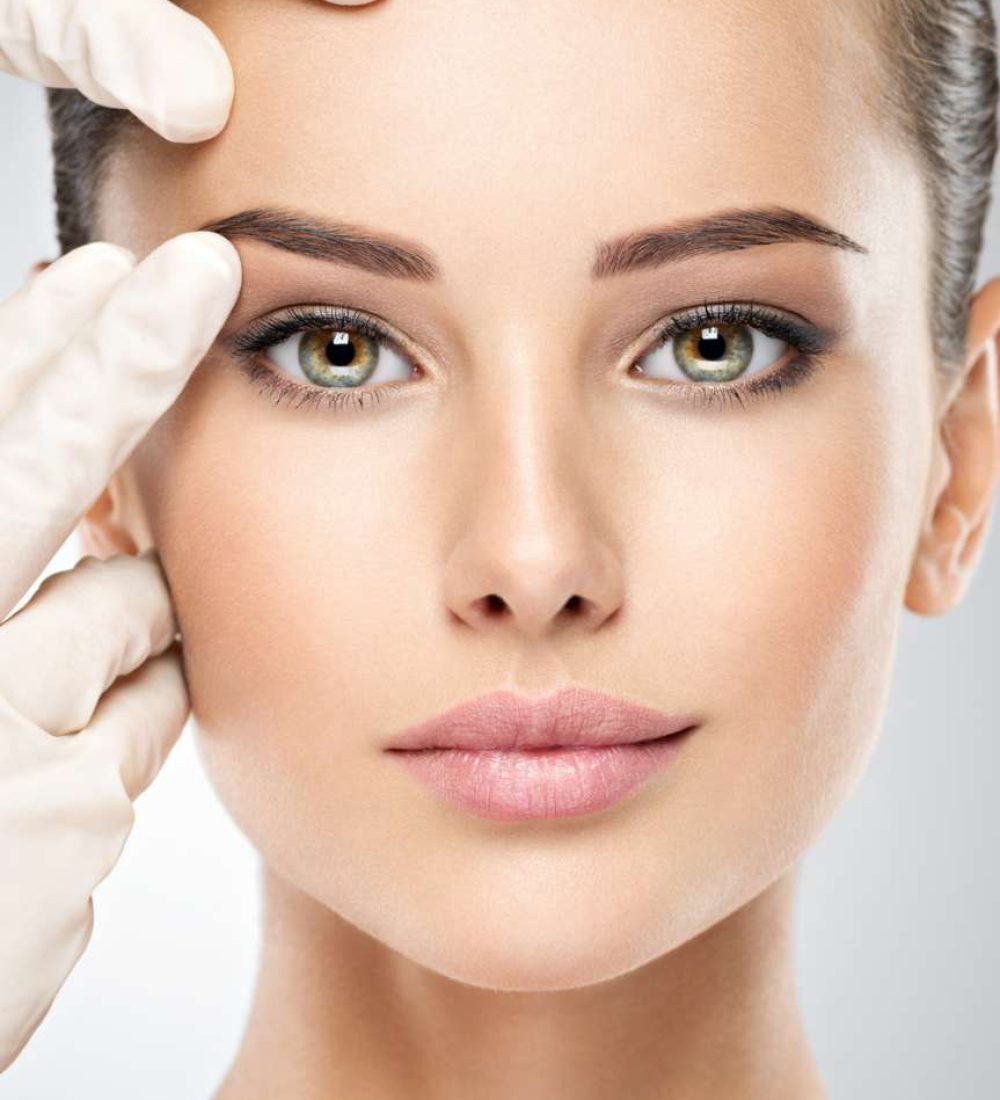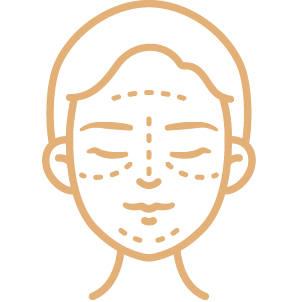Centrally located in Southampton, PA and serving Philadelphia, Bucks, and Montgomery Counties, The Kole Plastic Surgery Center performs brow lifts for patients desiring plastic surgery.
If there is one fundamental limitation to conventional facelifts, it would be that they only alter the appearance of the lower portion and mid portions of the face. Once the folds are diminished from the side of the nose to the corners of the mouth and the neck and jawline contours are restored, there can be an obvious contrast with how the upper face appears compared to the rejuvenated lower and mid face. For that reason, many of Dr. Kole’s facial cosmetic surgery patients elect to have a forehead lift or eyelid surgery in Bucks County, PA.
A brow lift—sometimes called a forehead lift—is a surgical procedure that restores a more youthful, refreshed look to the area of the forehead and the eyebrows. This procedure corrects drooping or poorly positioned brows and improves and minimizes the horizontal lines and furrows that can make a person appear sad, angry, or tired. In the forehead lift, the muscles and soft tissues that cause the drooping or furrows are weakened, removed, or altered to smooth the forehead and raise the eyebrows to a more pleasing position and minimize transverse frown lines.
Dr. Kole uses both the conventional and the endoscopic methods. The conventional surgical method uses an incision hidden just behind the hairline. The endoscopic brow lift method uses an endoscope, a surgical camera viewing system that allows the procedure to be performed with minimal incisions, all located within the hair of the scalp. Both techniques yield similar results which include minimizing forehead wrinkles and better overall brow position.
A forehead lift or brow lift is commonly performed in patients who range from 40 to 75 years old, to minimize the visible effects of aging and wrinkling. However, it can also help younger people or older people who have developed furrows or frown lines due to excessive stress or muscle activity. Individuals who have inherited low, heavy brows, furrow lines, or lines across the base of the nose can also achieve a more relaxed, refreshed, and alert look with this procedure.
For a better understanding of how a forehead or brow lift may change your appearance, look horizontally into a mirror. Place the palm of your hands in the outer edges of your eyes above your eyebrows and gently draw up the forehead skin to raise your brow and forehead without giving you a surprised look. This is approximately what a forehead lift would be able to accomplish surgically.
Forehead lifts or brow lifts are often performed in conjunction with facelift surgery to provide the upper one-third of facial rejuvenation that a facelift typically does not provide. This results in a rejuvenated appearance to the entire face.


Patients who have similar appearance concerns can often benefit from different treatments. Patients who complain of sagging skin in the upper eyelid frequently can get greater cosmetic benefit from forehead lifts rather than upper lid surgery, especially when the underlying cause of their cosmetic issue is low-set brows rather than excessive skin of the upper eyelids. Male patients who are older or have a receding hairline—and those who have had previous upper eyelid surgery—may be good candidates for forehead or brow lifts. Dr. Kole will simply alter the incision location or perform a more conservative operation depending on the hair line.
If you decide to consult Dr. Kole, he will evaluate your face—including the skin and underlying bone structure, as well as the musculature and fat. During your consultation, Dr. Kole will discuss your goals for surgery and asked you about certain medical conditions that could cause problems during or after your procedure such as uncontrolled high blood pressure, blood clotting problems, aspirin and nonsteroidal anti-inflammatory use and previous surgical procedures. Be sure to tell Dr. Kole if you smoke, take herbal supplements, or take medicines that may affect your clotting.
In the immediate period after your surgery, most patients experience some mild numbness and temporary discomfort around the incision area. This is controlled with prescription medications. Dr. Kole routinely uses long-acting local anesthesia to allow a smooth early postoperative period. Patients are typically told to sleep on two pillows to keep their head elevated for several days after surgery to minimize swelling. Swelling in the forehead may travel around the eyes and into the cheeks; however, swelling typically disappears in seven to ten days.
Several small nerves are cut in your scalp and the local area of numbness immediately adjacent to the incision will start to heal and may be replaced by minor itching. These nerve sensations may take as long as six months to fully resolve. The incisions are placed in a beveled-type fashion to minimize the hair loss that would be caused by damaging the hair follicles. Ideally, a scar in the hair-bearing area of the scalp will be camouflaged as new hair growth develops around and through the scar.
Both forehead lifts and eyelid surgery are types of facial cosmetic surgery that can significantly rejuvenate your appearance and refresh your conception of your identity. Kole Plastic Surgery and his well-trained, experienced staff are committed to helping patients obtain the realistic improvements they desire.
The price of a brow lift varies for each person. The cost depends on the extent of surgery necessary to achieve your individual appearance goal.
The Kole Plastic Surgery Center Center accepts cash, check, and credit card (MasterCard®, Visa®, American Express®, Discover®) as acceptable forms of payment.
Financing is also available through CareCredit®, United Medical Credit and Advanced Care.
A facelift, or rhytidectomy, is a surgical procedure to improve visible signs of aging in the face and neck. It will reshape the lower two-thirds of the face. It can tighten the skin and the underlying slack muscles to improve cheek, jowl, and neck contour. It is one of the most popular forms of facial plastic surgery. It’s most often performed on a patient over age 40 to rejuvenate the appearance.
It’s important to approach your procedure with a realistic attitude. A facelift acts to restore your original youthful appearance. It does not stop the aging process. It is recommended for people who do not smoke.
Although facelifts may take years off your appearance, it is important to understand what can be achieved with a resulting natural look and what professional facelift procedures cannot do. It primarily affects the lower half of the face, tightening and elevating loose and lax musculature, as well as repositioning fat and elevating skin of the folds between the nose and the mouth, the marionette lines vertically from the corners of the mouth, the jaw, and the neck. A mid-facelift also lifts the cheeks and lower eyelids. No facelift procedure corrects the signs of aging in the upper face, such as crows’ feet or forehead wrinkles. It is for this reason that a facelift is often combined with other procedures from a doctor with experience—such as a forehead lift or Botox® cosmetic injections—for total facial rejuvenation.
It’s not possible to stop or reverse aging with cosmetic procedures. What can be done is to repair some of the damage to your appearance caused by the aging process.
The cost for a one varies depending on the extent of operation necessary to achieve optimum results.
The Kole Plastic Surgery Center Center accepts cash, check, and credit card (MasterCard®, Visa®, American Express®, Discover®) as acceptable forms of payment.
Financing is also available through CareCredit®, United Medical Credit and Advanced Care.


The brow and forehead area are prone to sagging due to the aging process. Board certified plastic surgeon, Dr. Kole addresses this problem with brow lift surgery for men and women in Southampton, PA, Philadelphia County, Bucks County, Montgomery County and surrounding areas of Bucks County, PA. To learn how a brow lift will rejuvenate your appearance and help you look younger, contact us to schedule your personal consultation.
Centrally located in Southampton, PA and serving Philadelphia, Bucks, and Montgomery Counties, The Kole Plastic Surgery Center performs facelifts for patients desiring plastic surgery.

215-315-7655
Kole Plastic Surgery Center
We firmly believe that the internet should be available and accessible to anyone, and are committed to providing a website that is accessible to the widest possible audience, regardless of circumstance and ability.
To fulfill this, we aim to adhere as strictly as possible to the World Wide Web Consortium’s (W3C) Web Content Accessibility Guidelines 2.1 (WCAG 2.1) at the AA level. These guidelines explain how to make web content accessible to people with a wide array of disabilities. Complying with those guidelines helps us ensure that the website is accessible to all people: blind people, people with motor impairments, visual impairment, cognitive disabilities, and more.
This website utilizes various technologies that are meant to make it as accessible as possible at all times. We utilize an accessibility interface that allows persons with specific disabilities to adjust the website’s UI (user interface) and design it to their personal needs.
Additionally, the website utilizes an AI-based application that runs in the background and optimizes its accessibility level constantly. This application remediates the website’s HTML, adapts Its functionality and behavior for screen-readers used by the blind users, and for keyboard functions used by individuals with motor impairments.
If you’ve found a malfunction or have ideas for improvement, we’ll be happy to hear from you. You can reach out to the website’s operators by using the following email
Our website implements the ARIA attributes (Accessible Rich Internet Applications) technique, alongside various different behavioral changes, to ensure blind users visiting with screen-readers are able to read, comprehend, and enjoy the website’s functions. As soon as a user with a screen-reader enters your site, they immediately receive a prompt to enter the Screen-Reader Profile so they can browse and operate your site effectively. Here’s how our website covers some of the most important screen-reader requirements, alongside console screenshots of code examples:
Screen-reader optimization: we run a background process that learns the website’s components from top to bottom, to ensure ongoing compliance even when updating the website. In this process, we provide screen-readers with meaningful data using the ARIA set of attributes. For example, we provide accurate form labels; descriptions for actionable icons (social media icons, search icons, cart icons, etc.); validation guidance for form inputs; element roles such as buttons, menus, modal dialogues (popups), and others. Additionally, the background process scans all the website’s images and provides an accurate and meaningful image-object-recognition-based description as an ALT (alternate text) tag for images that are not described. It will also extract texts that are embedded within the image, using an OCR (optical character recognition) technology. To turn on screen-reader adjustments at any time, users need only to press the Alt+1 keyboard combination. Screen-reader users also get automatic announcements to turn the Screen-reader mode on as soon as they enter the website.
These adjustments are compatible with all popular screen readers, including JAWS and NVDA.
Keyboard navigation optimization: The background process also adjusts the website’s HTML, and adds various behaviors using JavaScript code to make the website operable by the keyboard. This includes the ability to navigate the website using the Tab and Shift+Tab keys, operate dropdowns with the arrow keys, close them with Esc, trigger buttons and links using the Enter key, navigate between radio and checkbox elements using the arrow keys, and fill them in with the Spacebar or Enter key.Additionally, keyboard users will find quick-navigation and content-skip menus, available at any time by clicking Alt+1, or as the first elements of the site while navigating with the keyboard. The background process also handles triggered popups by moving the keyboard focus towards them as soon as they appear, and not allow the focus drift outside it.
Users can also use shortcuts such as “M” (menus), “H” (headings), “F” (forms), “B” (buttons), and “G” (graphics) to jump to specific elements.
We aim to support the widest array of browsers and assistive technologies as possible, so our users can choose the best fitting tools for them, with as few limitations as possible. Therefore, we have worked very hard to be able to support all major systems that comprise over 95% of the user market share including Google Chrome, Mozilla Firefox, Apple Safari, Opera and Microsoft Edge, JAWS and NVDA (screen readers).
Despite our very best efforts to allow anybody to adjust the website to their needs. There may still be pages or sections that are not fully accessible, are in the process of becoming accessible, or are lacking an adequate technological solution to make them accessible. Still, we are continually improving our accessibility, adding, updating and improving its options and features, and developing and adopting new technologies. All this is meant to reach the optimal level of accessibility, following technological advancements. For any assistance, please reach out to
brow lift main line, brow lift philadelphia, botox brow lift philadelphia, forehead lift philadelphia, brow lift wayne pa, brow lift bucks county
The brow lift, also known as a forehead lift, is a surgical procedure that addresses concerns such as low, heavy brows, furrow lines, and lines across the base of the nose. This procedure can help create a more relaxed, refreshed, and alert appearance by smoothing the forehead and raising the eyebrows to a more pleasing position.
During the consultation, the plastic surgeon will evaluate the patient's facial features, including the skin, underlying bone structure, musculature, and fat. They will discuss the patient's goals for the surgery and address any medical conditions that could impact the procedure or recovery.
The brow lift procedure involves weakening, removing, or altering the muscles and soft tissues that cause the drooping or furrows in the forehead. This helps to smooth the forehead and elevate the eyebrows, resulting in a more youthful and rejuvenated appearance.
Patients can expect to see a reduction in transverse frown lines, a lifting and repositioning of the eyebrows, and an overall refreshed and alert look. The results of the brow lift can help patients achieve their aesthetic goals and boost their confidence.
The Kole Plastic Surgery Center accepts various forms of payment, including cash, check, and credit cards (MasterCard, Visa, American Express, Discover). Additionally, the center offers financing options through CareCredit, United Medical Credit, and Advanced Care to help patients manage the cost of the brow lift procedure.
Patients are encouraged to discuss the available payment options with the center's staff during their consultation to determine the best way to finance their desired procedure.
Before the brow lift surgery, patients will need to disclose any medical conditions, medications, or herbal supplements they are taking, as these can affect the procedure or recovery process. Patients may also be advised to stop taking certain medications, such as aspirin or non-steroidal anti-inflammatory drugs, to reduce the risk of bleeding and other complications.
After the surgery, patients will receive detailed instructions for their post-operative care, including wound management, activity restrictions, and any necessary follow-up appointments. The Kole Plastic Surgery Center team will closely monitor the patient's progress and provide support throughout the recovery period to ensure the best possible outcome.